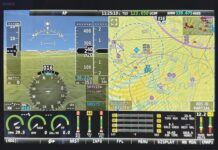One of the great things about experimental avionics has always been the ease of doing software updates – and the fact that most software updates bring us enhanced features well beyond what we might have been possible a few years ago. Add to that the fact that many of the software features and operational functionality we enjoy is beyond what our certified brethren can get as the icing on the cake. This is true for experimental EFISs, radios, and other electronic devices – but until recently, the same could not be said for the Certified IFR navigation devices we install in order to be legal while flying in the modern ATC system. Certified boxes had to be serviced and upgraded by certified technicians in certified repair stations, no matter what type of aircraft in which they were installed.
That changed when manufacturers began getting approval from the FAA for the field installation of software upgrades, so long as the box was installed in an experimental aircraft. We now appear to be seeing a more liberal trend within the FAA when it comes to installing safety-enhancing equipment in both certified and experimental aircraft, the idea being the obvious – if it makes flight safer, it has to be for the better, regardless of the paperwork involved. Yes, there is still paperwork – the manufacturers have to provide specific documentation for updates to allow the experimental operator to perform the upgrade – but for the person in the field, it is as simple as inserting a memory card or thumb drive with the new software (downloaded from the web), turning the unit on, and following the instructions.
A case in point is the latest update I just did to one of our airplanes equipped with the Garmin GTN 650. Up until earlier this year, the only way to legally update the box was to take (or send) it to an avionics shop approved by Garmin to do the work. Now, you can get the software off the web and do it yourself – and hundreds of operators have done so with success. It’s a good idea, of course, to follow all the instructions regarding recording and backing up software and hardware configurations – just in case. But the two upgrades we have done for ourselves on this box have gone without issues.
What do you get for the effort? In this case, quite a bit of new capability. For instance, here are just a few that GTN users have gotten in the last two upgrades:
- Customized holds
- Animated NEXRAD radar
- Fuel range ring
- Customer requests:
- GTN COM/NAV control from G3X Touch
- LP+V approach support
- Pinch-to-zoom on the map, traffic and terrain pages
- Compatibility with cost-effective Garmin Navigation Database
- Single updates start at $129 / annual subscription $299
As long as our avionics suppliers keep adding features and making upgrades simple – we’ll probably stay ahead of our certified friends. Try not to smirk.














